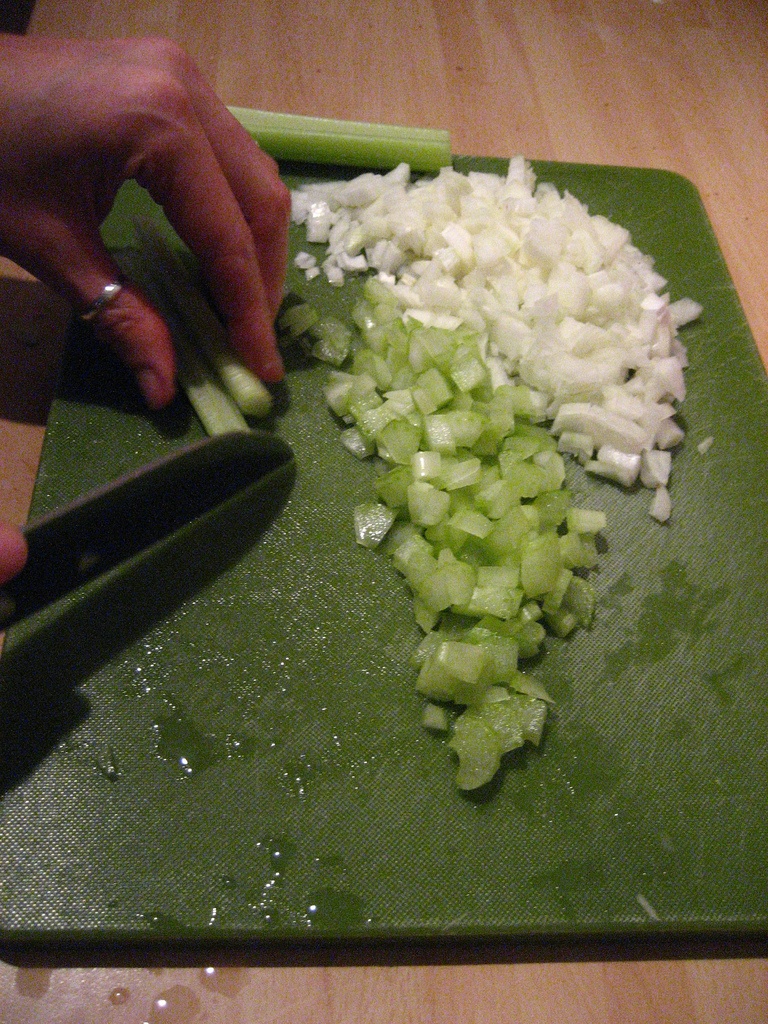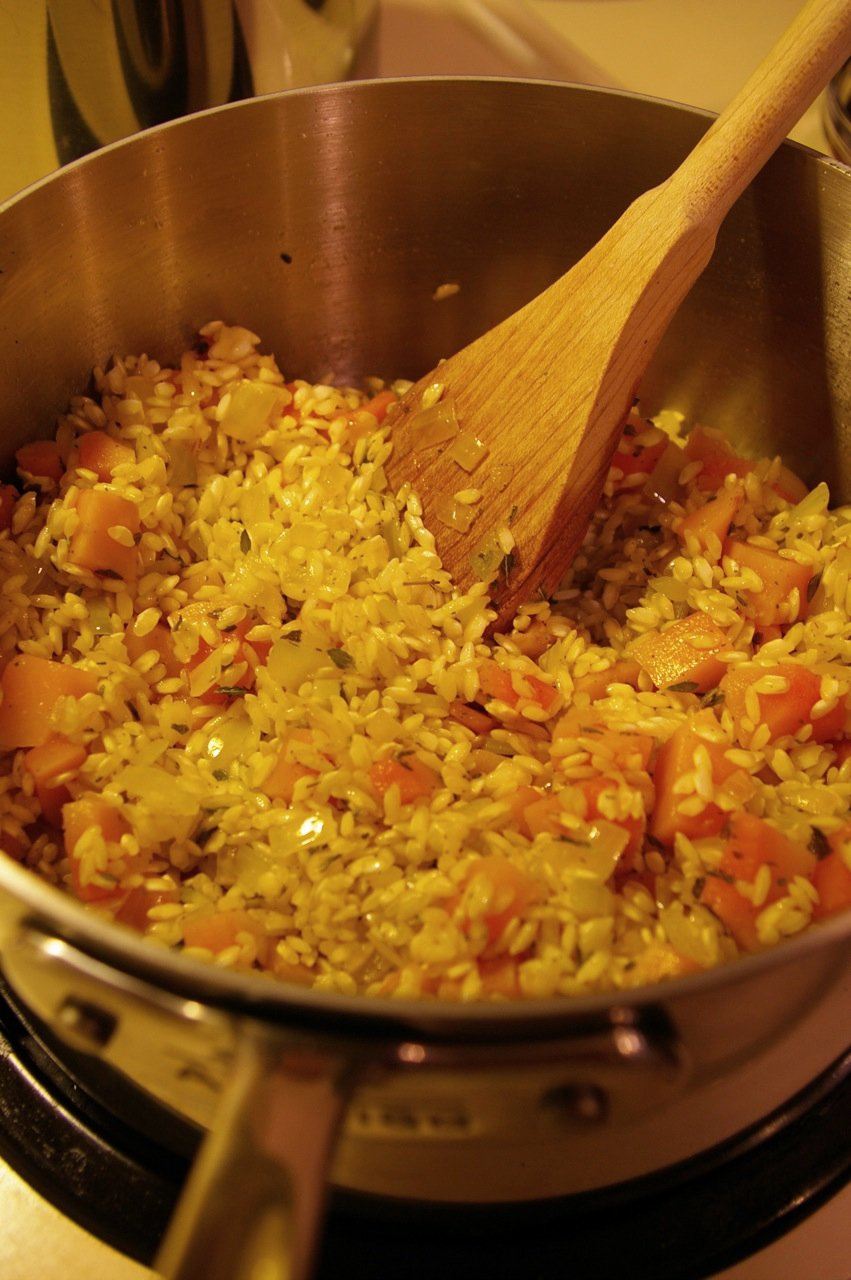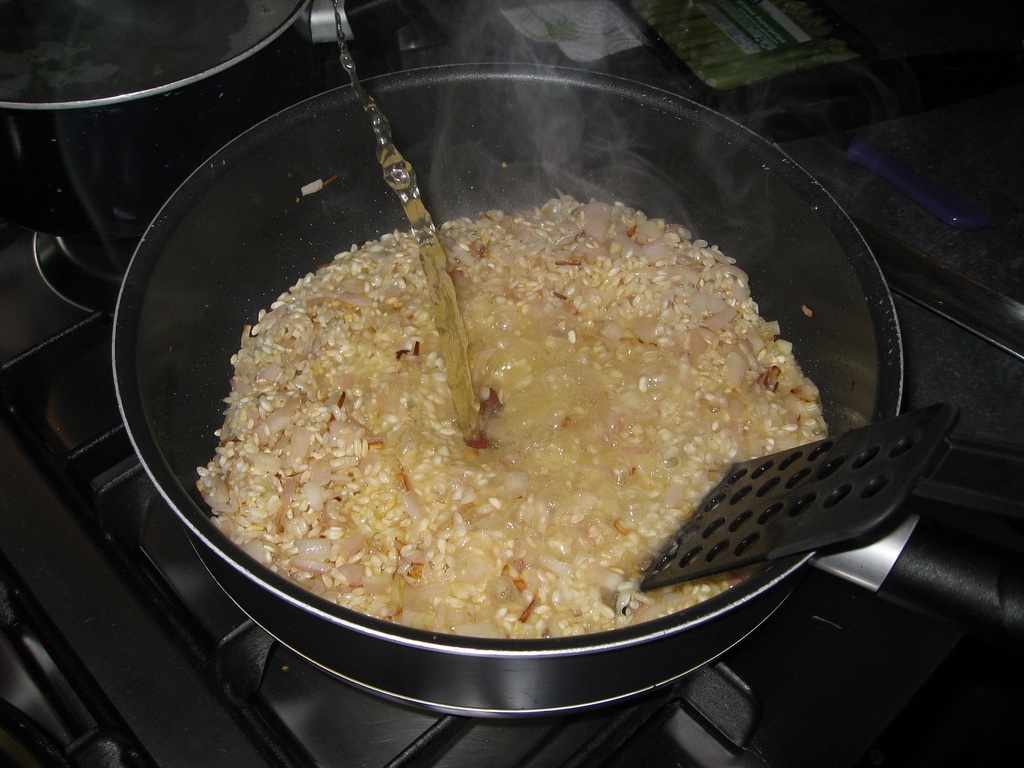Do take note that when I mention the creation of a dish, I’m not talking about warming up something frozen that you’ve bought at the grocery store—that’s not cooking, it’s a travesty waiting to happen. This is a meal that you create from scratch, so if you don’t yet know the difference between chopping and mincing, and think that deglazing is something you only do to windows, it’s best to do a bit of research on the basics first. Don’t worry, it’s not as scary as it sounds: chopping = cutting something fairly small; mincing = really tiny. That’s it. Oh, and use the sharp end of your knife to do all of this.
Risotto
That really is a gorgeous word, isn’t it? Roll it off your tongue a couple of times and you’ll see what I mean. It’s an Italian dish made with Arborio rice, which gets fabulously starchy as it cooks so the dish ends up rich and creamy. There are countless variations on flavour profiles that you can create, but this is a basic recipe you can use and build upon as you see fit. What you’ll need: 6-8 cups chicken or vegetable broth (I like to use onion) 2 tbsp olive oil 1 tbsp butter or margarine 1 large onion, finely chopped 1/4 cup celery, finely chopped 1 clove garlic, pressed or minced 1.5 cups Arborio rice 1/2 cup dry white wine sea salt black pepper 2 tbsp minced chives 1 extra tsp of butter or margarine 1/2 cup grated cheese, such as Parmigiano Reggiano
Step 1: Heat the Stock
In a medium-sized pot heat up the stock so that it comes to a light boil, and then turn the heat down to low to keep it hot, but not bubbling.
In a separate pot (or large, deep skillet—even a wok will do), heat the olive oil and butter on medium-high heat. When it starts to sizzle, add in the onions, garlic, and celery, and then turn the heat down to medium. You should be able to sautee them at this temperature for a good 10 minutes without them going brown. One the vegetables have softened and the onions are translucent, it’s time to add the rice.
Step 2: Rice
Once you’ve added the rice, turn the heat back up to high and stir it around immediately so that it gets a nice, even coating of fat all over it. Keep stirring it constantly, and after a minute or so you’ll notice that it starts to look a bit translucent. This is when you get to deglaze the pan so you lift all the delectable bits that the cooking vegetables have released, and the rice will get to suck the wine up into every single grain. *Note: make sure that you never cook with a wine that you wouldn’t serve at your table. The quality of the dish will be far better with a good wine, and you’ll get to sample it liberally as you cook.
Step 3: Add the Stock
When the rice has absorbed the wine, add a ladle of hot stock to the pan along with a pinch of sea salt, and turn the heat down to medium: you want the rice to simmer, but not burn. After that ladle-ful has been absorbed, add another one, constantly stirring that rice with your wooden spoon so you coax the starch out of the grains as they cook. This will take approximately 20 minutes or so, at which point you should taste the rice to see if it’s cooked. The grains should be mostly soft, but very slightly This is your opportunity to season the dish: does it need more salt? How about some cracked pepper? Stir these in as needed, and then remove the pan from the stove.
Step 4: Final Adjustments
It’s in this final step that you get to make the risotto your own. If you want to keep things simple, then just add in that extra dollop of butter or margarine, stir it around, and then let it sit for a couple of minutes so it gets creamy beyond measure. You can add in grated Parmigiano Reggiano, Asiago, or Romano cheese at this stage as well, and then garnish it with chives before serving. If you’re feeling a bit more adventurous, you could do a bit of prep work before starting the risotto so you can add extras to it, such as sauteed mushrooms or other vegetables. Some great ideas/combinations to try are: – Mixed fried mushrooms – Broccoli and lemon (you’d add a tbsp of lemon juice during the final step) – Asparagus tips – Spinach and feta (omit the parmesan) – Sundried tomato and basil
Mushrooms, broccoli, and asparagus need to be cooked before being added, while spinach and basil can just be chopped or shredded and added in raw in the final step: the heat from the rice will cook them lightly for you. Be sure to serve this with a glass of that wine you cooked with, and consider accompanying the dish with a light salad to cut the richness of it—a light salad of arugula/mixed greens with a lemon vinaigrette would do nicely. There you have it! Risotto might be a bit labour-intensive, but it really is worth the effort: once you and your companion take that first bite, you’ll see what I mean.



